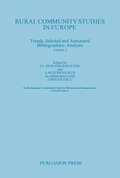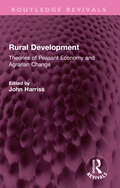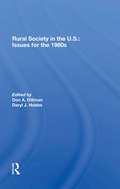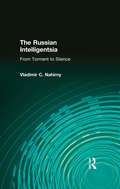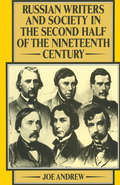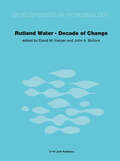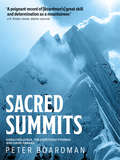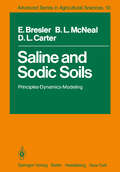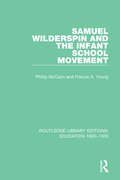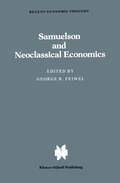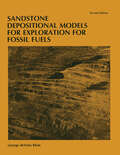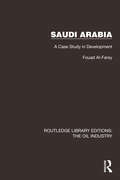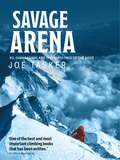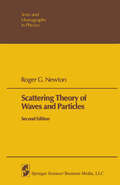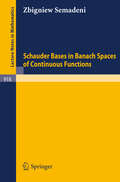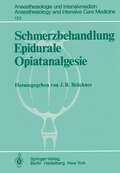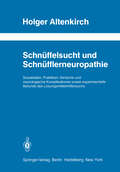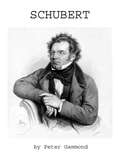- Table View
- List View
Rural Community Studies in Europe: Trends, Selected and Annotated Bibliographies, Analyses
by Jean-Louis Durand-Drouhin Lili Maria SzwengrubRural Community Studies in Europe: Trends, Selected and Annotated Bibliographies, Analyses, Volume 2 documents studies concerning several rural areas in Europe. The book presents information concerning a specific area, which includes a review of historical trends; annotated bibliography; and an analysis of studies conducted on the area. This volume particularly covers rural areas in the Netherlands, Germany, Hungary, Italy, and Finland. This book will be of great interest to researchers who require information about rural communities.
Rural Development: Theories of Peasant Economy and Agrarian Change (Routledge Revivals)
by John HarrissOriginally published in 1982, this book provides an important set of basic materials for students of rural development. Key papers have been chosen and arranged, and the editor has provided a general introduction and passages that link the papers, alerting the student to rival theoretical interpretations and to regional parallels and contrasts. The book provides a basis for the analysis of the processes that make rural societies and economies what they are and substantially determine the changes that take place within them. The papers help the reader to understand the nature of the phenomena with which rural development has to deal, and in doing so to begin to evaluate the interventions of agencies and planners.
Rural Development: Theories of Peasant Economy and Agrarian Change (Routledge Revivals)
by John HarrissOriginally published in 1982, this book provides an important set of basic materials for students of rural development. Key papers have been chosen and arranged, and the editor has provided a general introduction and passages that link the papers, alerting the student to rival theoretical interpretations and to regional parallels and contrasts. The book provides a basis for the analysis of the processes that make rural societies and economies what they are and substantially determine the changes that take place within them. The papers help the reader to understand the nature of the phenomena with which rural development has to deal, and in doing so to begin to evaluate the interventions of agencies and planners.
Rural Society In The U.s.: Issues For The 1980s
by Don A Dillman Daryl J HobbsMust rural Americans pay the price of urban progress and modern lifestyles? How will the increased pressures of the 1980s affect those who live and work in rural communities? In addressing these overriding questions the authors of this book take a serious look at such issues as who will operate our farms and how those farms will meet rising demands for food, how higher energy costs will change life in rural areas, the current and future needs of rural families and their communities, who in fact lives in these communities, and what can be done about escalating rural crime and recent social changes that have disrupted the traditional patterns of rural society. Because the United States is an interdependent system of rural and urban, of providers and consumers, these issues are vitally important to all-scholars, policy makers, and citizens alike. The contributors bring us up to date on the contemporary rural scene and offer suggestions for research essential to intelligent decision making about the challenges and problems the 1980s hold in store for rural America.
Rural Society In The U.s.: Issues For The 1980s
by Don A Dillman Daryl J HobbsMust rural Americans pay the price of urban progress and modern lifestyles? How will the increased pressures of the 1980s affect those who live and work in rural communities? In addressing these overriding questions the authors of this book take a serious look at such issues as who will operate our farms and how those farms will meet rising demands for food, how higher energy costs will change life in rural areas, the current and future needs of rural families and their communities, who in fact lives in these communities, and what can be done about escalating rural crime and recent social changes that have disrupted the traditional patterns of rural society. Because the United States is an interdependent system of rural and urban, of providers and consumers, these issues are vitally important to all-scholars, policy makers, and citizens alike. The contributors bring us up to date on the contemporary rural scene and offer suggestions for research essential to intelligent decision making about the challenges and problems the 1980s hold in store for rural America.
The Russian Intelligentsia
by Vladimir C. NahirnyVladimir C. Nahirny's brilliant study of major issues in Russian social and intellectual history synthesizes historical and sociological perspectives in an analysis of the nineteenth century Russian intelligentsia. He clarifies the concept of the intelligentsia itself, analyzes findings bearing on the social origins of different generations of intelligentsia, and enlarges understanding of conditions that facilitated the emergence of ideological groups among them. The Russian Intelligentsia develops a conceptually focused view of this distinct social group, arguing that the Russian intelligentsia can best be understood on the basis of orientation to ideas rather than on social or occupational position. Rather than simply providing an intellectual history or biographical sketches of major figures, Nahirny illuminates these concepts through data, creating an immersive context unlike other discussions of these groups. This book was, and will be, of interest to those interested in the problematic and contradictory social-political roles of intellectuals during this time.
The Russian Intelligentsia: From Torment To Silence
by Vladimir C. NahirnyVladimir C. Nahirny's brilliant study of major issues in Russian social and intellectual history synthesizes historical and sociological perspectives in an analysis of the nineteenth century Russian intelligentsia. He clarifies the concept of the intelligentsia itself, analyzes findings bearing on the social origins of different generations of intelligentsia, and enlarges understanding of conditions that facilitated the emergence of ideological groups among them. The Russian Intelligentsia develops a conceptually focused view of this distinct social group, arguing that the Russian intelligentsia can best be understood on the basis of orientation to ideas rather than on social or occupational position. Rather than simply providing an intellectual history or biographical sketches of major figures, Nahirny illuminates these concepts through data, creating an immersive context unlike other discussions of these groups. This book was, and will be, of interest to those interested in the problematic and contradictory social-political roles of intellectuals during this time.
Rutland Water — Decade of Change: Proceedings of the Conference held in Leicester, U.K., 1–3 April 1981 (Developments in Hydrobiology #8)
by David M. Harper J. A. BullockProceedings of a Conference on Rutland Water, held in Leicester, 1-3 April 1981
Sacred Summits: The Carstensz Pyramid, Kangchenjunga and Gauri Sankar
by Peter BoardmanMountaintops have long been seen as sacred places, home to gods and dreams. In one climbing year Peter Boardman visited three very different sacred mountains. He began on the South Face of the Carstensz Pyramid in New Guinea. This is the highest point between the Andes and the Himalaya, and one of the most inaccessible, rising above thick jungle inhabited by warring Stone Age tribes.During the spring Boardman made a four-man, oxygen-free attempt on the world's third highest peak, Kangchenjunga. Hurricane-force winds beat back their first two bids on the unclimbed North Ridge, but they eventually stood within feet of the summit – leaving the final few yards untrodden in deference to the inhabiting deity. In October, he climbed the mountain most sacred to the Sherpas: the twin-summited Gauri Sankar. Renowned for its technical difficulty and spectacular profile, it is aptly dubbed the Eiger of the Himalaya and Boardman's first ascent took a gruelling twenty-three days.Three sacred mountains, three very different expeditions, all superbly captured by Boardman in Sacred Summits, his second book, first published shortly after his death in 1982. Combining the excitement of extreme climbing with acute observation of life in the mountains, this is an amusing, dramatic, poignant and thought-provoking book.Peter Boardman and Joe Tasker died on Everest in 1982, whilst attempting a new and unclimbed line. Both men were superb mountaineers and talented writers. Their literary legacy lives on through the Boardman Tasker Prize for Mountain Literature, established by family and friends in 1983 and presented annually to the author or co-authors of an original work which has made an outstanding contribution to mountain literature.
Saline and Sodic Soils: Principles-Dynamics-Modeling (Advanced Series in Agricultural Sciences #10)
by E. Bresler B. L. McNeal D. L. CarterIn keeping with the spirit of an Advanced Series in the Agricultural Sciences, we have attempted to address herein most of the current research areas being used to characterize, describe and manage salt-affected soils. Because of a certain amount of personal bias inherent in our individual viewpoints and backgrounds, some areas have been accorded more emphasis than others. It has been our goal, however, to provide either detail about, or at least a recent reference to, each major area of current soil salinity research. This information, coupled with what we hope to be a rather logical progression from descriptive material on equilibrium or near-equilibrium soil chemistry, through transport processes, to eventual management practices including some elementary economic decisions, should enable the reader to bridge the gap from introductory soil chemistry or soil physics texts to the basic literature of this area. The text will be perceived by the astute reader as somewhat uneven in its treatment of respective sections. We feel that this is to a certain extent appropriate, for it thus portrays the unevenness of progress to date in the corresponding areas of research. The management of saline and sodic soils remains largely an empirical semi-science or even art, whereas transport phenomena are normally dealt with in a much more theoretical (and also a much more highly mathematical) vein. Equilibrium soil chemistry has historically occupied an intermediate position with respect to its mix of empiricism and theoretical rigor.
Samanata
by Shri. Dinkar Sakrikarप्रस्तुत भाषांतर हे टॉने याच्या ‘इक्वालिटी’ या ग्रंथाचे आहे. या ग्रंथात त्यांनी समानतेच्या संकल्पनेचा अत्यंत सांगोपांग व शास्त्रशुद्ध असा उदापोह केला आहे. त्यांची समानतेची कल्पना ही सामाजिक न्यायाच्या संपूर्ण अशा आकलनावर आधारलेली आहे, समाजाच्या मध्यवर्ती आणि चिरस्थायी अशा प्रक्रियेतच समानता अनुस्यूत असली पाहिजे. समाजातील लोकांचे परस्परांशी उचित संबंध अशी ते समानतेची व्याख्या करतात. हा संपूर्ण विचार त्यांच्या मूळ ग्रंथातूनच समजून घेतला पाहिजे.
Samuel Wilderspin and the Infant School Movement (Routledge Library Editions: Education 1800-1926)
by Phillip McCann Francis A. YoungSamuel Wilderspin became a household name in his own lifetime. Befriended by Dickens, lampooned by Cruikshank, his achievements discussed in Parliament, he was one of the best known educators of the 1830s and 1840s. However, Wilderspin’s consistent opposition to denominational education combined with his liberal and advanced views made him unpopular with the Establishment. Samuel Wilderspin’s fame declined after his retirement in 1847 but his reputation as an infant school educator has survived. Many of his ideas and practices have had a great influence on infant education. In this book, first published in 1982, Wilderspin’s own story is placed in the context of this growing movement led by Owen, Buchanan and Oberlin, and it goes a long way towards reinstating him as one of the prominent figures in the early education movement. This title will be of interest to students of history and education.
Samuel Wilderspin and the Infant School Movement (Routledge Library Editions: Education 1800-1926 #11)
by Phillip McCann Francis A. YoungSamuel Wilderspin became a household name in his own lifetime. Befriended by Dickens, lampooned by Cruikshank, his achievements discussed in Parliament, he was one of the best known educators of the 1830s and 1840s. However, Wilderspin’s consistent opposition to denominational education combined with his liberal and advanced views made him unpopular with the Establishment. Samuel Wilderspin’s fame declined after his retirement in 1847 but his reputation as an infant school educator has survived. Many of his ideas and practices have had a great influence on infant education. In this book, first published in 1982, Wilderspin’s own story is placed in the context of this growing movement led by Owen, Buchanan and Oberlin, and it goes a long way towards reinstating him as one of the prominent figures in the early education movement. This title will be of interest to students of history and education.
Samuelson and Neoclassical Economics (Recent Economic Thought #1)
by G. FeiwelThis is not a festschrift, but a study of the prodigious Samuelson phe nomenon, his history-making contributions to and impact on the econom ics of our age, and the intricate, often perplexing, and divergent trends in modern economics - all intensely controversial subjects that will be argued, scrutinized, and periodically reassessed by economists of various strands and traditions for years to come, for, as Samuelson wrote of Pigou, "immortality does have its price. " A scholar with such an out standing body of contributions "must expect other men to swarm about it" (1966, p. 1233), subject it to scholarly scrutiny, and challenge it. Although Paul Samuelson was 65 on May 15, 1980 (and our best wishes go out to him for long life and continued enrichment of economics), this is neither a birthday party nor a gathering of only the Good Fairies, for, as he himself has said of Marx, "a great scholar deserves the compliment of being judged seriously" and critically (1972, p. 268). In accordance with the rule of Roman law, audiatur et altera pars, I have invited representative scholars of widely divergent perceptions to offer their critical evaluation of the "age of Samuelson. " While the response was by and large gratifying, some scholars were unable to meet the deadline, ix x PREFACE and with much compunction I have had to expand my own essays to partly fill the gaps.
Sandstone Depositional Models for Exploration for Fossil Fuels
by G. Devries KleinThe purpose of this monograph is to provide participants in my various short courses with a brief statement of the material I cover in my lectures. In addition, key illustrations are reproduced for guidance. A brief bibliography of reference material is appended to each chapter. The bibliographic material includes those references that I consider critical to my remarks. No claim is made of topical or bibliographic completeness. This monograph also is intended as a brief summary of depositional processes, Holocene sediments, ancient counterparts of depositional environments, and examples of oil- and gas-bearing stratigraphic traps in five depositional environments. This summary is intended to complement lecture and reading courses dealing with sedimentology, depositional systems, sedimentary facies, sedimentary environments, sandstone diagenesis, and sedimentary modelling as a predictive tool for exploration. The student is cautioned, however, that this monograph is merely an introduction and summary overview of the subject. More complete treatments appear in standard textbooks. Sedimentology has changed and advanced over the past twenty-five years, in part because the American oil industry needed to make predictions about the occurrence of the harder-to-find stratigraphic traps. In addition, the development of plate-tectonic theory, and supportive data from the Deep Sea Drilling Project, have caused sedimentology to change from an essentially descriptive science to a mature, predictive science. The 1960s and 1970s in particular witnessed an explosion of new insights and understanding of how sediments are deposited, and how sedimentary rocks are formed.
Saudi Arabia: A Case Study in Development (Routledge Library Editions: The Oil Industry #9)
by Fouad Al-FarsySaudi Arabia (1986) is a major study of the political and administrative development of Saudi Arabia following its establishment as a leading world exporter of oil. It looks at the status of oil in the development of the state, as well as the political systems of government in the Kingdom.
Saudi Arabia: A Case Study in Development (Routledge Library Editions: The Oil Industry #9)
by Fouad Al-FarsySaudi Arabia (1986) is a major study of the political and administrative development of Saudi Arabia following its establishment as a leading world exporter of oil. It looks at the status of oil in the development of the state, as well as the political systems of government in the Kingdom.
Savage Arena: K2, Changabang and the North Face of the Eiger
by Joe TaskerI could never again maintain that I was caught up in this game unwillingly. I knew now what I wanted to do. Willingly would I accept the hardship and fear, the discipline and the sacrifices, if only I could be given back the chance to climb that mountain.' Joe Tasker lies, struck down by a tooth abscess, in a damp, bug-infested room in the Himalaya, wondering if he will be well enough to climb Dunagiri, his first venture to the 'big' mountains. He is there with Dick Renshaw to attempt to make a two-man ascent of the Peak - one of the first true Alpine-style expeditions to the Greater Ranges; an attempt that forms part of this tale of adventure in the savage vertical arena of hostile mountains. Joe Tasker was one of Britain's foremost mountaineers. A pioneer of lightweight mountaineering and a superbly gifted writer, in Savage Arena he vividly describes his participation in the first British winter ascent of the North Face of the Eiger; his first ascent of the West Wall of Changabang with Peter Boardman - considered to be a preposterous plan by the established climbing world; the first ascent of the North Ridge of Kangchenjunga; and his two unsuccessful attempts to climb K2, the second highest mountain in the world. This is a story of single-minded determination, strength and courage in a pursuit which owes much of its value and compulsion to the risks entailed - risks which often stimulate superlative performances. It is also a story of the stresses, strains and tensions of living in constant anxiety, often with only one other person, for long periods in which one is never far from moments of terror, and of the close and vital human relationships which spring from those circumstances. It is a moving, exciting and inspirational book about the adventuring spirit which seeks endless new climbing challenges to face, alluring problems to solve and difficulties to overcome, for it is not reaching the summit which is important, but the journey to it. Joe Tasker and Peter Boardman died on Everest in 1982, while attempting a new and unclimbed line. Both men were superb mountaineers and talented writers. Tasker's first book, Everest the Cruel Way, was first published in 1981. Savage Arena, his second book, was completed just before he left for Everest. Both books have become mountaineering classi. The literary legacy of Tasker and Boardman lives on through the Boardman Tasker Prize for Mountain Literature, established by family and friends in 1983 and presented annually to the author or co-authors of an original work which has made an outstanding contribution to mountain literature. For more information about the Boardman Tasker Prize, visit: www.boardmantasker.com 'The most riveting book on climbing that I have ever read.' Chris Bonington 'A gripping story of tremendous courage and unbelievable endurance.' Sir Edmund Hillary
Scattering Theory of Waves and Particles (Theoretical and Mathematical Physics)
by R.G. NewtonMuch progress has been made in scattering theory since the publication of the first edition of this book fifteen years ago, and it is time to update it. Needless to say, it was impossible to incorporate all areas of new develop ment. Since among the newer books on scattering theory there are three excellent volumes that treat the subject from a much more abstract mathe matical point of view (Lax and Phillips on electromagnetic scattering, Amrein, Jauch and Sinha, and Reed and Simon on quantum scattering), I have refrained from adding material concerning the abundant new mathe matical results on time-dependent formulations of scattering theory. The only exception is Dollard's beautiful "scattering into cones" method that connects the physically intuitive and mathematically clean wave-packet description to experimentally accessible scattering rates in a much more satisfactory manner than the older procedure. Areas that have been substantially augmented are the analysis of the three-dimensional Schrodinger equation for non central potentials (in Chapter 10), the general approach to multiparticle reaction theory (in Chapter 16), the specific treatment of three-particle scattering (in Chapter 17), and inverse scattering (in Chapter 20). The additions to Chapter 16 include an introduction to the two-Hilbert space approach, as well as a derivation of general scattering-rate formulas. Chapter 17 now contains a survey of various approaches to the solution of three-particle problems, as well as a discussion of the Efimov effect.
Schauder Bases in Banach Spaces of Continuous Functions (Lecture Notes in Mathematics #918)
by Z. SemadeniSchlag nach!: 100000 Tatsachen aus allen Wissensgebieten
by Fachrekationen Des Fachrekationen Des Bibliogra InstitutsSchmerzbehandlung Epidurale Opiatanalgesie: Ergebnisse des Zentraleuropäischen Anaesthesiekongresses Berlin 1981 Band 3 (Anaesthesiologie und Intensivmedizin Anaesthesiology and Intensive Care Medicine #153)
by J. B. BrücknerSchnüffelsucht und Schnüfflerneuropathie: Sozialdaten, Praktiken, klinische und neurologische Komplikationen sowie experimentelle Befunde des Lösungsmittelmißbrauchs (Schriftenreihe Neurologie Neurology Series #23)
by Holger AltenkirchSchubert (The\composer As Contemporary Ser.)
by Peter GammondFranz Schubert was born on January 31 1797 and lived in Vienna, the cultural hub of Europe at a time of continuous political and intellectual upheaval. Schubert himself, however, preferred a secluded existence in drawing-rooms and coffee houses with his literary and artistic friends. He did not have the advantages of an academic background or of rich patronage and consequently he was never well off and suffered great neglect in his lifetime. His health deteriorated and he died before his 32nd birthday on November 19 1828 but he had been extremely prolific during his lifetime. His output consists of more than 600 secular vocal works, seven complete symphonies, sacred music, operas, incidental music and a large body of chamber and piano music. Appreciation of his music while he was alive was limited to a relatively small circle of admirers in Vienna but interest in his work increased significantly in the decades following his death with such luminaries as Felix Mendelssohn, Robert Schumann, Franz Liszt, Johannes Brahms and other 19th-century composers championing his works. Today, Schubert is ranked among the greatest composers of the late Classical and early Romantic eras and is one of the most frequently performed composers of the early 19th-century.
